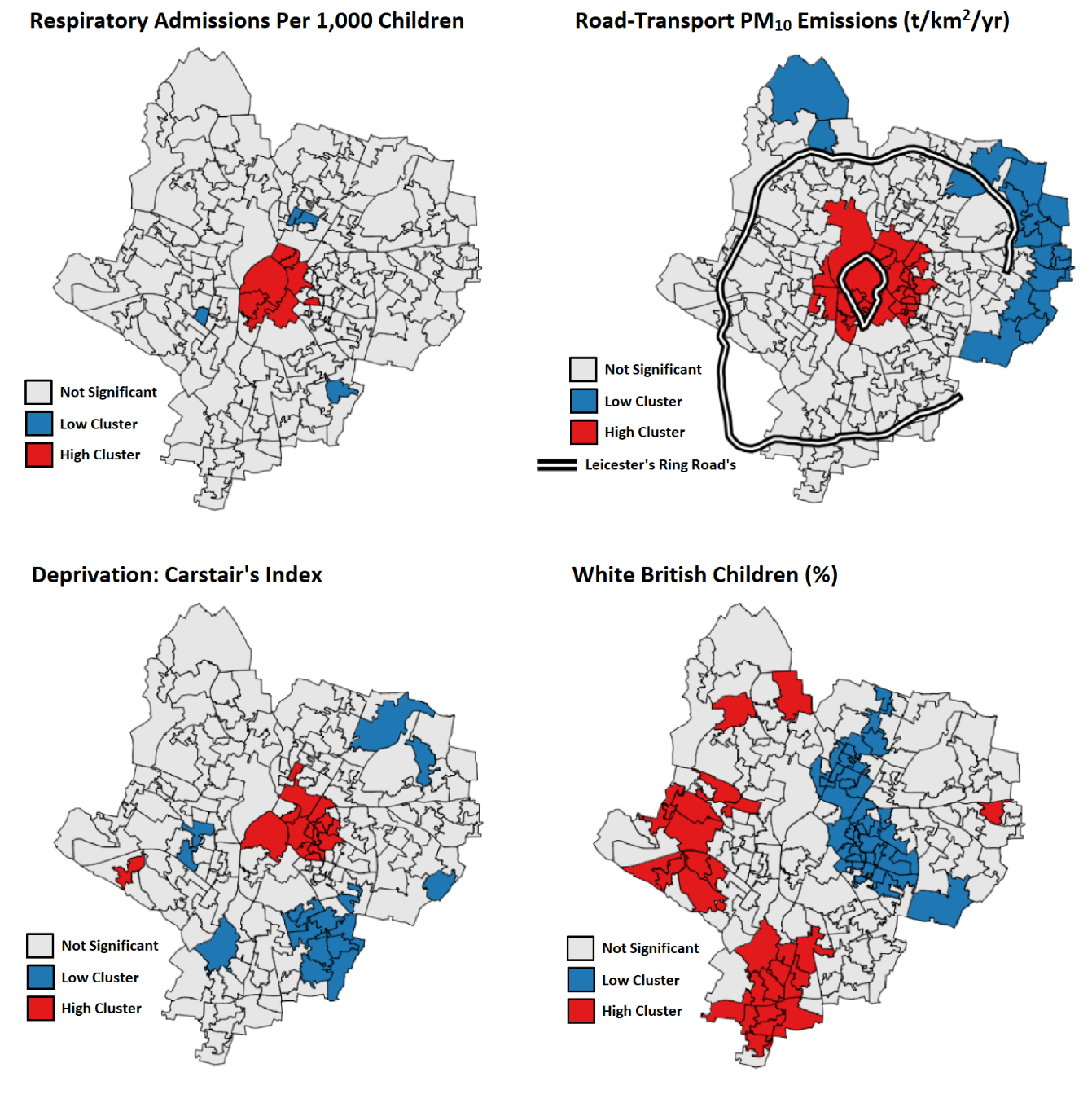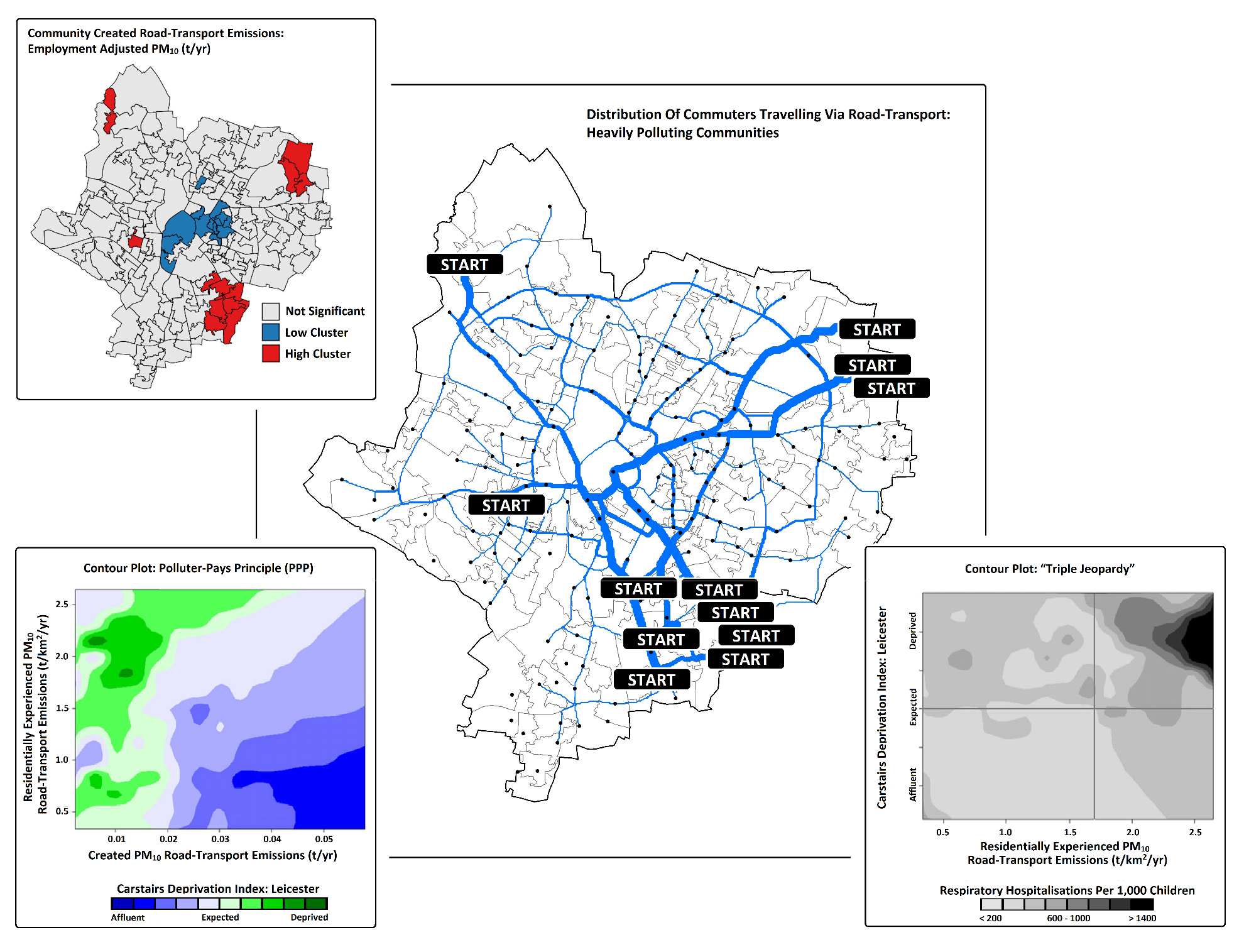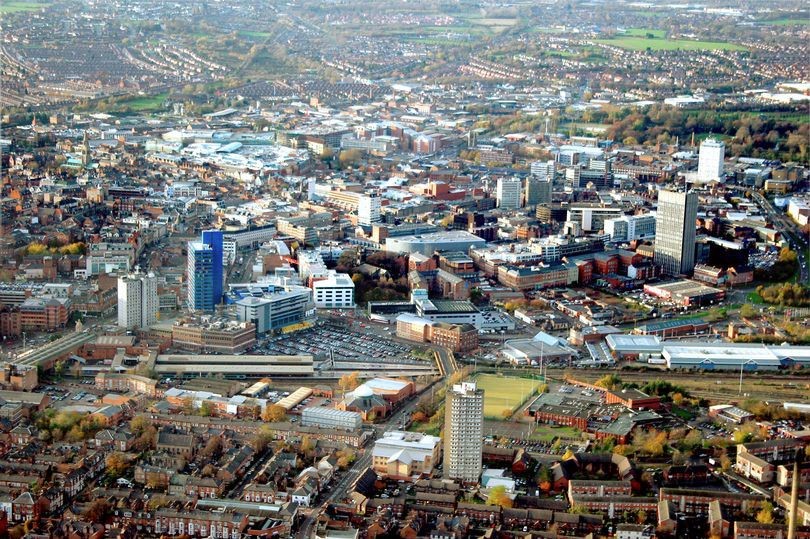Dr Calvin Jephcote | Toxic Expertise Research Fellow | University of Warwick, UK
Approximately 33% of European citizens are exposed to air pollutant levels that exceed EU air quality standards, and 90% of urban residents experience levels of air pollution which the World Health Organisation consider as damaging to health.
Particles below 10μm in aerodynamic diameter (PM10), are thought to be one of the most harmful anthropogenic air pollutants in the Post-industrial cityscape. When inhaled, a substantial proportion of these foreign particles can evade the respiratory system’s natural defences and lodge deep in the lungs, hypothetically lowering the body’s immune system and aggravating existing conditions in sensitive individuals. Exposure to environmental agents during childhood is of particular concern, with prolonged contact periods stunting the development of vital cardiorespiratory organs, causing ailments which may prevail throughout adulthood.
Epidemiological studies have consistently demonstrated that numerous health problems, can be caused or worsened by exposure to particulates on a day-to-day basis. Seminal research from 90 US and 29 European locations, respectively identified a 0.3% and 1.0% increase in respiratory mortalities and hospitalisations for each 10μg/m3 increase in 24-hour PM10 levels at city centre monitoring stations. On this basis, particulate pollution typically accounts for 1.7% of London’s respiratory related hospitalisations, rising to 9.8% during severe pollution events. However, personal exposure to environmental agents is rarely uniform – 20% of the UK’s most deprived citizens reside in neighbourhoods with high particulate pollution levels, compared to only 2% of those that are affluent. Across the UK, particulate matter is thought to contribute to 29,000 deaths per annum, contributing to more premature deaths than passive smoking and traffic accidents combined.
The significant contribution of road-transport to air pollution within the post-industrial cityscape is widely acknowledged, with vehicles emitting vast quantities of particulates from incomplete combustion and mechanical wear close to residential areas. Of the 600 local Air Quality Management Areas (AQMAs) declared in the UK – areas which breach UK national air quality objectives – some 94% are a result of transport activity. Furthermore, the historically confined nature of European intra-urban environments tends to create extreme spatial variations in traffic pollutant levels, which are often associated with a plethora of social disparities that collectively influence community wellbeing.
Jephcote & Chen (2012, 2013) and Jephcote et al (2014, 2016) illustrate the importance of the spatial dimension, when exploring the relationship between health inequalities and exposure to road-transport emissions. Although it is useful for health practitioners to understand the citywide health burden of an air pollution event, the elevated impact on those most vulnerable communities – not representative of the general populace – is often lost. Through considering spatial variations in children’s respiratory health, this research aimed to address the inadequacies of traditional temporal modelling practices in capturing the ‘triple jeopardy’ of social, environment and health inequalities.
This research explored the presence of environmental (in)justice within Leicester, an archetypal multicultural British city that is home to approximately 62,500 children aged 0-15 years, of which 47% are from ethnic minority groups. The city is relatively deprived, ranked as the 31st poorest out of 354 Local Authorities in England. Leicester is currently ranked as the 98th most congested city in the world, with trips across the city’s highways, arterial and local roads taking on average 23% longer than expected, rising to 53% during peak flow periods.
The analysis combined a road transport emission inventory formed from traffic count points, with demographic records from the UK census and National Health Service (NHS) for 187 intra-urban communities. Approximately 24,500 children’s respiratory hospital admissions were recorded over the 10-year study period of 2000-09, equating to an annual citywide rate of 394 respiratory hospitalisations per 10,000 children.
Pattern detection statistics were used to describe the spatial structures across the city of Leicester, identifying whether neighbouring communities record an attribute of interest at a significantly higher or lower value than the citywide average. The resulting hotspots revealed that children from lower social class households tended to reside within areas experiencing relatively high levels of road-transport emissions and experienced the highest rates of emergency respiratory hospitalisations (see FIGURE 1).
Further tests found that these peaks in road-transport emissions were responsible for elevated children’s respiratory admissions, within 283m of a pollution hotspot. This distance-response threshold was identified to reduce in relation to certain ethnic groups, which would imply that environmental injustices prevail within an integrated multicultural city.
In terms of local transport policy, it should be noted that the eastern section of the cities outer ring road remains incomplete and is unlikely to materialise any time soon, despite the routes continued safeguarding within local transport plans. Traffic is currently forced to leave the outer ring road and join a single carriageway to the city centre, bypassing some of the most affluent communities and causing congestion in central locations during peak hours.

FIGURE 1: Hot-spot analysis of annual average children’s respiratory related hospital admissions and other socioeconomic factors of potential influence (Source: Jephcote & Chen 2013).
A regression analysis was then used to simultaneously explain how several socioenvironmental factors may influence respiratory hospitalisation rates. This process iteratively allocates a certain number of hospital cases to each competing socioenvironmental influence, until a stable estimate is established.
The models were designed to account for spatial dependency in the data and to embrace the possibility of geographically unique relationships existing across the city, following the detection of socioenvironmental structures. Reasons to suspect why any relationship may vary over space, include:
- Differences in sampling quality – i.e. traffic count points
- Relationships naturally change over space – i.e. behavioural, lifestyle choices and administrative structures may produce different responses to the same stimuli.
- “Spillover effects” – i.e. environmental burdens are not just experienced at the point of release, but across neighbouring communities.
The localised regression models resulted in the formation of a dose-response relationship, which identified each tonne of residentially experienced PM10 road-transport emissions to be accountable for 54 respiratory hospitalisations per 1,000 children each year.
The threshold for the occurrence of hospitalisation was identified to occur within areas experiencing annual rates of PM10 road-transport emissions above 0.9 tonnes per km2 – the citywide average emission rate is 1.1 tonnes per km2. To the authors knowledge this is the first time a dose–response relationship has been specifically associated with road-transport emissions.
Inner-city communities were typically exposed to an additional 0.8 tonnes per km2, which annually equates to 43 more respiratory hospitalisations per 1,000 children than what was recorded by other communities.
Successive research identified a spatial association between acute infections of the upper (URTI) and lower (LRTI) respiratory tract, particularly within inner-city communities. URTIs and LRTIs were respectively found in 42% and 24% of children’s respiratory hospitalisations in the City of Leicester. It is theorised that exposure to detrimental socioenvironmental factors may initiate URTI episodes, with prolonging recovery times likely occurring from sustained exposures. If a sufficient level of recovery is not reached in time for the cold season, then the child may become host to a viral infection exacerbating previous respiratory complaints, potentially resulting in lower respiratory tract conditions of greater severity.
This condition may be described as ‘Catarrhal Child Syndrome’ (CCS), which relates to the repeated access of medical services for respiratory related infections during childhood – caused by the susceptibility of a developing immunological system to external stimulants. Despite its frequency, affecting up to 80% of children, its causes remained uncertain and it is speculated that a combination of socioenvironmental and viral factors are at play. The presented findings merit further research, and further highlight the necessity to examine inequalities at a local scale.
After establishing the link between respiratory health, deprivation and environmental exposures, the authors research sought to investigate the Polluter-Pays Principle (PPP) at a local scale – the notion that environmental actions embody mechanisms for assigning culpability, shifting the burden of mitigation to the polluters rather the polluted.
Community created road-transport emissions were estimated from DVLA vehicle records and census information on workforce trips by mode of transport – commuters represent the lion’s share of population movements.
Pattern detection statistics identified inverse relationships between mobile polluters and communities characterised as either socially or environmentally burdened, confirming the existence of environmental inequalities (see FIGURE 2). Whilst some inner-city communities moderately contribute towards their environmental burden, these contributions were substantially outweighed by those made by external communities, whom appear to avoid the social, environment and physical cost of their actions.
Commutes were shown to have a centric focus, with mechanical forms of road-transportation from highly polluting communities passing through less affluent neighbourhoods – typically located within close proximity to places of work. It is likely that the movement of commuting vehicles through these neighbourhoods would result in congestion, causing a localised increase in PM10 contributions.
In contrast to their more affluent counterparts, residents of less affluent areas tended to use ‘greener’ and more active transport options, although any associated health benefits appeared largely offset by increased periods of environmental exposure.
It is concluded that the creation of a traffic management scheme, which reduces the level of air pollutants and adheres to the PPP, can only be achieved from a combination of localised and citywide measures that collectively address the contributions of public and private transport.
Lower level schemes would focus on the needs of individual communities, supporting the poorest communities with improved public transport – rerouting a centric focused bus network to out-of-town employment hubs – and schemes to help maintain their vehicles that have high polluting potentials. The negative stigma of public services amongst affluent communities also requires further investigation – although park and ride schemes are near to these peripheral communities, a lack of comfort, luxury and the prohibitive financial and time costs impede their uptake. For these communities, the design of local carpooling schemes could provide an acceptable and immediate response for mitigating their environmental contributions.
In terms of higher level schemes, the implementation of a Scandinavian style ‘Passive Low emission Zone’ (PLEZ) based on window screen permitting could restrict the movement of those most polluting commercial and public heavy-duty vehicles. A central ‘Bus Gate Enforcement’ zone would likely curb the magnitude of environmental burdens placed on vulnerable inner-city residents from peripheral communities, who could switch to using existing-park-and-ride infrastructure – this action is also dependent on the introduction of a cleaner hydrogen or electric bus fleet.
However, the switch to an electric fleet is not without its own problems. There are issues relating to how this energy is sourced, especially when fossil fuels still account for 51% of electricity produced in the UK. Furthermore, the average lifespan of a vehicles lithium-ion battery is only 8-years, most of which will enter landfill where it may contaminate water supplies and impact local ecology, as no established recycling plans currently exist. Greater focus should be placed on achieving a hydrogen economy, although there are financial and political barriers which need to be overcome. Companies that have invested in the infrastructure of oil and gas are likely to resist such changes, as is local and national governance. The UK government currently collects approximately £28bn from duties on petrol and diesel, with local government pension schemes also seen to profiteer from investments in fossil fuels. While a fossil fuel economy is a valuable source of revenue, it flies in the face of the Paris Agreement, and contradicts efforts to reduce emissions locally.
Completion of the outer ring road, included in a package of over £2,000,000 in road improvements across the city, would reduce the number of vehicles presently entering the city centre. However, such designs are unlikely to materialise – roadbuilding is not prioritised by central government, local authorities are faced with diminishing budgets and a substantial carbon impact would have to be accommodated for during the construction phase. Thus, demonstrating the complexity of tackling both local and global pollution concerns.

FIGURE 2 – The identification of polluting and burdened community hot-spots, travel patterns of commuters from polluting communities, and citywide plots providing a summary of the local Polluter-Pays Principle and “Triple Jeopardy” effect (Sources: Jephcote & Chen 2012, Jephcote et al 2016)
REFERENCES
ATKINSON, R., ANDERSON, H., SUNYER, J., AYRES, J., BACCINI, M., VONK, J., BOUMGHAR, A., FORASTIERE, F., FORSBERG, B., TOULOUMI, G., SCHWARTZ, J., & KATSOUYANNI, K. (2003). Acute effects of particulate air pollution on respiratory admissions. In: Revised Analyses of Time-Series Studies of Air Pollution and Health. Special Report 14. Boston, USA: Health Effects Institute
COMMITTEE ON THE MEDICAL EFFECTS OF AIR POLLUTANTS. (COMEAP 2010). The Mortality Effects of Long-Term Exposure to Particulate Air Pollution in the United Kingdom. London, UK: Department of Health, Her Majesty’s Stationary Office
DEPARTMENT FOR ENVIRONMENT, FOOD AND RURAL AFFAIRS. (DEFRA 2006). Air quality and social deprivation in the UK: An environmental inequalities analysis. Didcot, UK: AEA Technology
DEPARTMENT FOR BUSINESS, ENERGY & INDUSTRIAL STRATEGY. (BEIS 2017). Digest of United Kingdom energy statistics 2017
DEPARTMENT FOR ENVIRONMENT, FOOD AND RURAL AFFAIRS. (DEFRA 2018). Air Quality Management Areas. Retrieved on 30 May 2018 from: http://aqma.defra.gov.uk/aqma/home.html
DOMINICI, F., MCDERMOTT, A., DANIELS, M., ZEGER, S., & SAMET, J. (2003). Mortality among residents of 90 cities. In: Revised Analyses of Time-Series Studies of Air Pollution and Health: Special Report 14. Boston, USA: Health Effects Institute
EUROPEAN ENVIRONMENT AGENCY. (EEA 2013). Air quality in Europe: 2013 report. Luxembourg: Publications Office of the European Union, No 9/2013.
GAINES, L. (2014). The future of automotive lithium-ion battery recycling: Charting a sustainable course. Sustainable Materials and Technologies, pp.2-7
INSTITUTE OF OCCUPATIONAL MEDICINE (IOM). Comparing estimated risks for air pollution with risks for other health effects. Research Report TM/06/01. Edinburgh, UK.
INMAN, P. (2017). Treasury will need to plug gap in tax as drivers switch to electric cars. The Guardian, Wednesday 26th July 2017. Retrieved on 31 August 2018 from: www.theguardian.com/politics/2017/jul/26
JEPHCOTE, C., & CHEN, H. (2012) Environmental injustices of children’s exposure to air pollution from road-transport within the model British multicultural city of Leicester: 2000-09. Science of the Total Environment. 414, pp.140-151
JEPHCOTE, C., & CHEN, H. (2013). Geospatial analysis of naturally occurring boundaries in road-transport emissions and children’s respiratory health across a demographically diverse cityscape. Social Science & Medicine, 82, pp.87-99
JEPHCOTE C., ROPKINS K., & CHEN H. (2014). The effect of socio-environmental mechanisms on deteriorating respiratory health across urban communities during childhood. Applied Geography. 51C, pp.35-47
LEICESTER CITY COUNCIL. (LCC 2011). Leicester’s Local Transport Plan 2011-2026: “Planning for people not cars”, Part A – The Transport Strategy. Leicester, UK: Regeneration, Highways and Transportation
MONTAGUE, B. (2017). Councils in UK invest £16.1 billion in fossil fuels. The Ecologist, Thursday 9th November 2017. Retrieved on 31 August 2018 from: https://theecologist.org/2017/nov/09/councils-uk-invest-ps161-billion-fossil-fuels
OFFICE FOR NATIONAL STATISTICS. (ONS 2003). UK Census 2001: Standard Area Statistics. CasWeb, Census Dissemination Unit, MIMAS (University of Manchester)
OFFICE FOR NATIONAL STATISTICS. (ONS 2008). Index of Multiple Deprivation 2007: Measure of multiple deprivation at small area level made up of seven domains. Newport, UK: Neighbourhood Statistical Releases, Department for Communities and Local Government
TOMTOM INTERNATIONAL (2015). TomTom Traffic Index, 2014. Amsterdam, Netherlands. Retrieved on 01 June 2015 from: www.tomtom.com/en_gb/trafficindex/#/list
UNITED NATIONS. (UN 2015). Paris Agreement Paris Agreement, Chapter XXVII: Environment.
VOELCKER J (2016). Electric car battery warranties compared. Green Car Reports, Tuesday 20th December 2016. Retrieved on 31 August 2018 from: www.greencarreports.com/news/1107864
